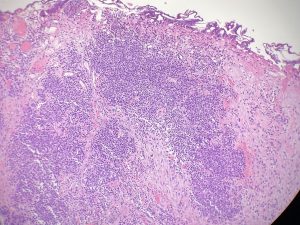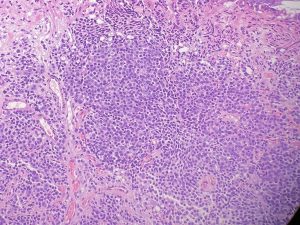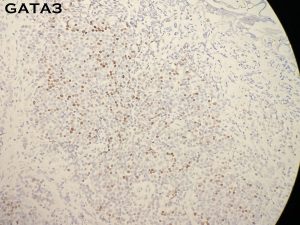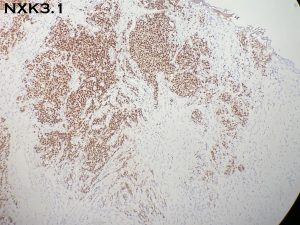CASE OF THE WEEK
Editor: Mahmut Akgul (akgulm@amc.edu)
2022-27/July 11
Contributors: Ankur Sangoi
Male in his 70s presents without prior malignancy history presents with symptoms of benign prostatic hyperplasia, transurethral resection is performed.
CLICK ON THE BELOW THUMBNAILS TO ENLARGE PHOTOS.
Quiz
a) NKX3.1, p63, high mol weight cytokeratin, p501s
b) CD56, uroplakin2, vimentin, pankeratin
c) p501S, synaptophysin, desmin, AE1/AE3
d) PSMA, uroplakin3, p40, CK20
1. a
NKX3.1, p63, high mol weight cytokeratin, p501s
Additional immunostains performed show diffuse strong positivity for NKX3.1 (Figure 6), diffuse strong positivity for pankeratin, negative staining for high molecular weight cytokeratin, and negative staining for p63. The overall morphologic and immunophenotypic findings are those of a high grade (Grade group 5) prostatic adenocarcinoma, with aberrant GATA3 positivity.
This uncommon phenomenon has recently been reported, and is typically encountered in high grade prostate cancers. When in doubt a panel approach is recommended, with other prostatic markers (PSAP, PSA, p501S) and urothelial markers (p63, high molecular weight cytokeratin, uroplakin2) often helpful in arriving at the correct diagnosis. Importantly, morphology remains a staple to avoid this potential pitfall: features favoring prostatic origin including monomorphic nuclei with prominent nucleoli, cribriform/glandular growth, and pale/foamy cytoplasm versus features favoring urothelial origin including more severe nuclear pleomorphism with mitotic activity, infiltrative/irregular nested growth, and dense/eosinophilic cytoplasm. Caution be taken in interpreting “colonization” by prostatic adenocarcinoma which can mimic in-situ urothelial carcinoma components as well as “pseudopapillary” architecture by prostatic adenocarcinoma which can mimic papillary urothelial carcinoma components. Moreover, nuclear atypia should be interpreted with caution as rare cases of pleomorphic giant cell pattern prostatic adenocarcinoma have been described, although these typically not the predominant pattern and show background traditional acinar pattern prostatic adenocarcinoma.
McDonald TM, Epstein JI. Aberrant GATA3 Staining in Prostatic Adenocarcinoma: A Potential Diagnostic Pitfall. Am J Surg Pathol. 2021 Mar 1;45(3):341-346.
Ankur Sangoi
El Camino Hospital
Mountain View, CA
Prostate
Prostatic adenocarcinoma, GATA3, grade group 5, NKX3.1







